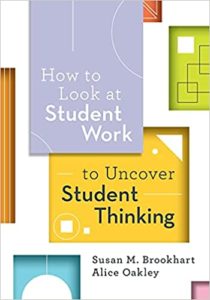Look at Student Work to See Student Thinking
How to Look at Student Work to Uncover Student Thinking
By Susan M. Brookhart and Alice Oakley
(ASCD, 2021 – Learn more)
Reviewed by Josefine Carrion-Dreyer

Not in the sense of grades, but in the sense of not providing enough support. I did not fully understand why my students didn’t “get” an assignment or did poorly on an assessment.

We know how to look at standards and include them within our lesson plans. We learn how to deliver lessons (wholeheartedly or not). We also use various types of assessments to ensure that students “get” the lesson.
But how many times do we stop to understand how our students reacted to a lesson? When do we tell ourselves, “Let me go back into my students’ work, compare it against my delivery, and see why they didn’t ‘get’ it”?
Pausing to understand student thinking
Student learning should go beyond the lesson delivery and the assessment that follows. Student learning should include a “pause” on the teacher’s end to evaluate a student’s thought process, not just the end-product.
In How to Look at Student Work to Uncover Student Thinking, the authors bring forth what many of us have forgotten: “The quality of the learning goal and criteria, the richness of assignments and assessments, and the alignment of all three affect how much and what kind of thinking students can demonstrate” (p 12).
In simpler terms, knowing what to teach, how to teach it, and what to assess can make more sense if teachers understand a student’s thought processes. The need for the “pause” should be front and center to understand how a student internalizes information and what they do with it throughout an assignment or assessment.
Susan Brookhart and Alice Oakley stress and underscore how important it is to look beyond the grade that we give a student and, instead of looking for correctness, we look at student work as proof that they truly are thinking.
More about the book
The book is divided into four main parts that we should take into consideration when focusing on student work:
- understanding student thinking,
- providing effective feedback,
- deciding on next instructional moves, and
- supporting professional development.
A chapter is dedicated to each part, with helpful examples from real situations in different classrooms and levels.
Additionally, there are several supporting sidebar features throughout the book: a short summary at the end of each chapter; a “Coach’s Corner” that includes hints for helping teachers regarding each topic, and a section of “Reflection Questions” that allows a teacher to self-assess how they are incorporating (or could incorporate) ideas from each chapter.
Throughout the book readers can also find rubrics and graphic organizers to help them focus on continuing to understand student thinking.
Inferring what students are thinking and the success criteria
Being knowledgeable about the content that is being taught is not enough. Teachers should be clear on the learning goals and the focus of the assessment. Just because a student scores a high grade on an assessment does not always mean that the student grasped the content.
Teachers need to be able to infer what students were thinking while they completed an assignment or assessment. Knowing the place where students start when working on an activity and what they are learning in the process will help us guide students to where they need to go with the information.
For example, Brookhart and Oakley explain that if a teacher creates a fill-in-the-blank activity (with the Word Bank included), can the teacher identify the process of understanding the student went through to know which words to choose? Did the student choose the correct words because he knew the definitions? Or did he use context clues for the definitions he did not know?
The authors remind us that when we grade student work, we should ensure that we are not thinking about compliance with directions but about achieving the predetermined learning goals. This is where success criteria come in. Success criteria are not about a grade or score but rather about certain characteristics regarding the assignment that students focus on while they work, which in turn allows the teacher to identify student understanding.
Effective feedback
After we connect the dots regarding student thinking (how they got to where they are with an assignment or assessment), then we can identify if the student needs additional support. If this is the case, then our feedback needs to be effective. One great takeaway from How to Look at Student Work to Uncover Student Thinking is how to provide effective feedback.
Feedback moves learning forward when students receive responses to their work […], and then have additional work opportunities in which they can use the feedback within the same formative learning cycle.” (p 52).
When giving feedback, many teachers may make one or both of the following mistakes: (1) wait too long to provide it, or (2) want to “fix” what’s wrong within the assignment. Writing comments such as “Great job!” or “Excellent!” does not help students know what was so great or excellent. We need to use what the authors call “descriptive feedback.”
For feedback to be useful and effective, enough details need to be included. Descriptive feedback helps students connect the provided guidance to the learning process; this will show students where they are and where they need to go. Our feedback should highlight strengths and provide ideas on what needs work.
I know from experience that grading essays and providing timely and effective feedback can be overwhelming, time consuming (staying after school, grading throughout the weekends), and, more times than not, I have felt the desire to just “fix” the essays and move on.
But we cannot. If we want to teach a student how to read, we teach letter sounds, word recognition, etc., then we model, and finally let the student read. We could spend years reading to children, but for them to learn on their own, we need to allow them to go through the process. This is the same when providing effective feedback: students need to take what we give them and go through the process of seeing what they “got” and what still needs work.
Next instructional moves
The authors present an idea that is tied to a simple question, what should teachers do after they provide students with the necessary feedback? Answer: focus on moving students forward. In the book we can find many examples shared by teachers on what to look for and do while moving students forward in their academic journey.
Brookhart and Oakley point out that, regardless of the subject (language arts, math, science, music, art, sports, etc.), when teachers search for evidence of student thinking, it helps identify any misconceptions or misunderstandings a student may have. This translates into helping students succeed.
In addition, there are several ideas on how to support students’ next moves: from least formative with no student participation (going over an assignment and providing correct answers, then continuing with the lesson) to most formative (deconstructing a task, differentiation of the next lesson).
Supporting professional development
Professional learning is not just participating in training, webinars, or conferences. Professional development can result when we have teachers look at student work (separately and together) to bring forth many foundational outcomes: an increase in teacher content knowledge; better understanding of student learning, improvement in the assessment process; providing effective feedback, among others.
Providing teachers with opportunities to move away from a focus on instruction to a focus on looking at student work helps teachers better understand student thinking. A teacher can come full circle by identifying what they notice in the student’s work, then providing effective feedback and finally planning next steps.
If a teacher needs ideas on how to deconstruct student work and dig deeper into a student’s thought process, How to Look at Student Work to Uncover Student Thinking can be a great guide.
Josefine Carrion-Dreyer, J.D., B.S., M.S., M.Ed. left the legal profession twenty years ago to become a bilingual educator. She has taught all levels: elementary, middle, high school, undergraduate and graduate. She currently teaches middle school English Language Arts where she enjoys supporting English Language Learners (ELLs). She has served as team leader, Model UN advisor, mentor for new teachers, principal at an IB World School, and Education Specialist for Major League Baseball in Latin America and the Caribbean.






























